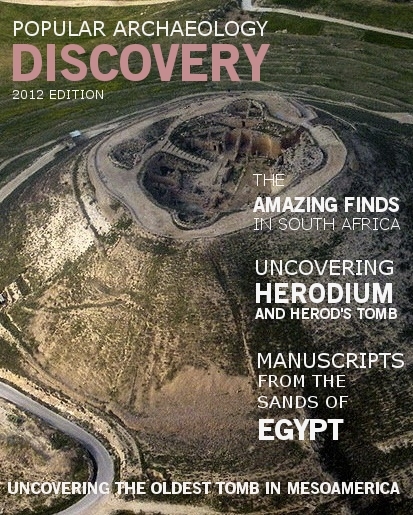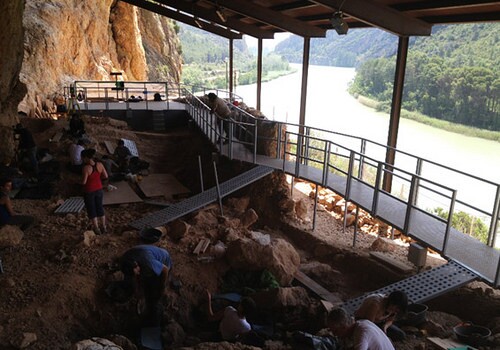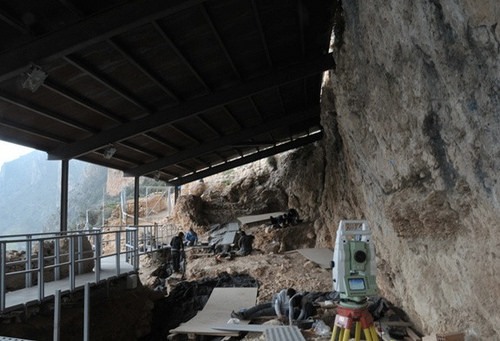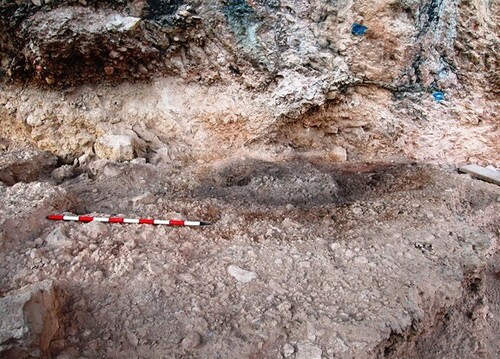
A rock shelter site located above the river Segre in the Pyrenees foothills of northeastern Spain is yielding evidence of Neanderthal occupation that could post-date 40,000 years BP, according to researchers. This would place the ancient occupiers among the last Neanderthals to inhabit the area of present-day Europe, and finds at the site could provide clues to how the Neanderthals adapted to changing environmental circumstances and whether or not they coexisted with the emerging modern human populations in the region.
Called La Roca dels Bous, the rock shelter has been the subject of intense excavation and study by archaeologists and student volunteers under the joint direction of Dr. Rafael Mora Torcal of the Universitat Autònoma de Barcelona, Ma. Xavier Roda Gilabert of the Ministry of Science and Innovation of the Spanish Government, and Adrià Millán Gil of archaeoBarcelona. Their excavations have uncovered materials typically associated with Neanderthals, including flint artifacts characteristic of the Middle Paleolithic period (300,000 – 30,000 yr. BP), and bones from animals that are known from previous research to have been a part of the Neanderthal diet, such as red deer, wild horses, and wild goats. Other finds included a number of hearths, or areas where the inhabitants used controlled fire.
“One of the most interesting characteristics of this site is the role it might have played in the mobility of the Neanderthals,” write Torcal and colleagues in a recent report. “The archaeological floors [of the] Neanderthals of La Roca dels Bous (La Noguera, Catalunya, Spain) had surprisingly few lithic artifacts and scarce animal remains. Layers of hearths with no apparent organization were discovered by the wall of the rock shelter. Fires appear repeatedly along the stratigraphic sequence and could be interpreted as resulting from ongoing short-term settlements. The combination of these factors suggests that small groups consistently chose La Roca dels Bous as a temporary shelter as they moved through wide areas, possibly following the migratory routes of their prey.”*
_________________________________________________________________________________________
Above and below: Overview of the Roca dels Bous rock shelter site. Courtesy Adrià Millán, Wikimedia Commons(above);
Courtesy CEPAP-UAB (below)
________________________________________________________________________________________
______________________________________________________________________________________________________________________
View of an excavated hearth at the La Roca dels Bous rock shelter. Courtesy CEPA-UAB
________________________________________________________________________________________
But perhaps the most most interesting find of all related to the date of occupation. Several carbon-dating analyses using the 14C AMS dating technique on samples removed from the site indicated dates around 38,000 BP.
“The oldest Neanderthal sites known in the nearby areas date back to around 40,000 BP,” writes Torca, et al. “And the first settlements attributed to the “anatomically modern” Homo sapiens in Northern Spain are dated around 39,000-38,000 BP. All this would suggest that Neanderthals could have persisted in this particular area longer than previously believed, preceding the arrival of the first Homo sapiens [anatomically modern humans] to the area.”*
……..Or concurrent with them, as some scholars theorize. It has been suggested that modern humans appeared in what is today Europe around 40 – 50,000 years ago. Scientists point to research analyses of evidence recovered from excavations in the northern parts of the Iberian Peninsula, where artifacts dated to around 40,000 BP indicating an emerging new techno-tradition significantly different from that usually used by the Neanderthals. The new tradition, they theorize, was introduced by modern humans who may have arrived in Europe from the Eastern Mediterranean.
The research team hopes that, ultimately, the site will present new evidence that will shed additional light on an intensely debated topic: Did Neanderthal and modern human populations coexist in the area and did they interact with each other?
Excavations will continue at the site from June 6th to July 10th, 2014. Individuals interested in participating in the excavations may obtain aditional information at archaeoBarcelona.
_________________________________
* http://www.sha.org/documents/RocadelsBousArchaeologicalProject2014web.pdf
_________________________________________________________________________________________
Read about the most fascinating discoveries with a premium subscription to Popular Archaeology Magazine. Find out what Popular Archaeology Magazine is all about. AND MORE:
 On the go? Purchase the mobile version of the current issue of Popular Archaeology Magazine here for only $2.99.
On the go? Purchase the mobile version of the current issue of Popular Archaeology Magazine here for only $2.99.
And, Popular Archaeology’s annual Discovery edition is a selection of the best stories published in Popular Archaeology Magazine in past issues, with an emphasis on some of the most significant, groundbreaking, or fascinating discoveries in the fields of archaeology and paleoanthropology and related fields. At least some of the articles have been updated or revised specifically for the Discovery edition. We can confidently say that there is no other single issue of an archaeology-related magazine, paper print or online, that contains as much major feature article content as this one. The latest issue, volume 2, has just been released. Go to the Discovery edition page for more information.
Subscription Price: A very affordable $5.75 for those who are not already premium subscribers of Popular Archaeology Magazine (It is FREE for premium subscribers to Popular Archaeology). Premium subscribers should email [email protected] and request the special coupon code. Or, for the e-Book version, it can be purchased for only $3.99 at Amazon.com.







